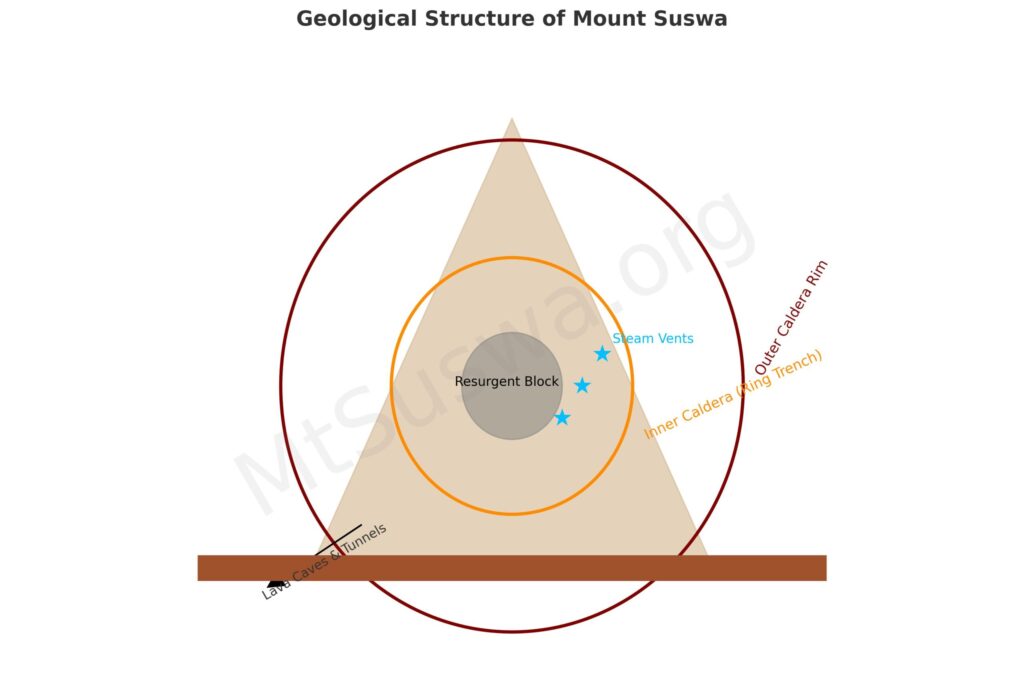Mount Suswa’s distinctive shape—with a double caldera structure (an outer and inner crater)—is the result of a complex sequence of volcanic and tectonic events, shaped by magma dynamics, collapse processes, and prolonged geological activity within the Kenya Rift Valley. Here’s how it formed:
🌋 The Formation of Mt. Suswa’s Unique Shape
1. Shield Volcano Formation (Stage S1)
Mt. Suswa began as a low, broad shield volcano, formed by the eruption of trachytic lava flows. These flows spread gently outward from fissures, building the wide volcanic base we see today. This early phase produced:
- Domes and lava cones
- Lightly inclined lava flows
- Initial buildup of elevation (~2,000 m)
2. First Caldera Collapse (Outer Caldera)
As magma accumulated beneath the mountain and then emptied during large explosive eruptions, the ground surface collapsed, forming a large outer caldera (approx. 12 km wide). This is a common feature in volcanoes that undergo magma chamber drainage. The collapse was likely incremental, occurring in several episodes, rather than a single massive event.
This outer caldera gives Mt. Suswa its broad, circular shape when viewed from satellite images.
3. Explosive and Phreatomagmatic Activity
During and after the outer caldera’s formation, Suswa experienced explosive eruptions, producing:
- Pumice lapilli tuffs and pyroclastic flows
- Globule ignimbrites (unique rounded volcanic fragments)
- Deposits formed by magma-water interaction, or phreatomagmatism
This stage added complexity to the volcanic layers, shaping parts of the inner topography.
4. Rebuilding Phase and Second Collapse (Inner Caldera / Ring Trench)
After the first collapse, a new volcanic cone—called Ol Doinyo Onyoke—began to form inside the outer caldera. As magma accumulated again beneath this central cone and then rapidly withdrew, a second collapse occurred, forming a deep inner caldera or ring trench, about 5 km across. This is Mt. Suswa’s most visually striking feature:
A “crater within a crater.”
This inner caldera contains:
- A tilted block of land (a resurgent dome)
- Steam vents and fumaroles (evidence of ongoing geothermal activity)
- A network of lava caves and tunnels along its edge
5. Post-Caldera Eruptions (Recent Activity)
Following the double caldera formation, lava continued to erupt, especially along fractures on the south and southeastern flanks. These flows are mostly phonolitic, slightly more evolved than earlier trachytes.
Some of these flows are geologically recent—possibly less than 1,000 years old.

🗺️ Summary: Why Mt. Suswa Looks the Way It Does
| Feature | Cause |
|---|---|
| Outer Caldera | Formed by collapse after major magma withdrawal (explosive eruptions) |
| Inner Caldera (Ring Trench) | Secondary collapse of a resurgent cone inside the outer caldera |
| Tilted Block | Uplifted floor from magma pushing upward, then collapsing |
| Lava Caves | Formed during low-viscosity lava flows beneath solid crust |
| Current Shape | Shaped by multiple eruptions, caldera collapses, and flank lava flows over ~240,000 years |
Mt. Suswa’s form is a textbook example of nested calderas, rare even among volcanoes globally. Its structure offers geologists insight into magma chamber evolution, phreatomagmatic interaction, and the tectonic processes of the East African Rift.
🏔️ FAQs: How Did Mount Suswa Form?
❓What type of volcano is Mount Suswa?
Mount Suswa is a complex shield volcano with a rare double-caldera structure. It was built primarily by trachytic lava flows and shaped by explosive eruptions and collapse events over thousands of years.
❓Why does Mount Suswa have two craters?
Suswa has a double caldera because it experienced two separate collapse events:
- The outer caldera (~12 km wide) formed when the volcano’s magma chamber drained after major eruptions, causing the surface to collapse.
- The inner caldera (also called the ring trench) formed later when a central cone (Ol Doinyo Onyoke) collapsed inward, creating a deep moat-like depression inside the larger crater.
❓How old is Mount Suswa?
Mount Suswa is estimated to be over 240,000 years old, based on K-Ar dating of its earliest lava flows. Its most recent eruptions likely occurred within the last 1,000 years.
❓What caused the calderas to form?
The calderas were created by caldera collapse events—large depressions formed when magma chambers emptied rapidly during major eruptions, causing the ground above to sink.
❓What are “globule ignimbrites” and why are they important?
Globule ignimbrites are unique volcanic deposits made of rounded volcanic ash particles that formed during phreatomagmatic eruptions (magma interacting with water). Mount Suswa is one of the few places in the world where these rare formations are well preserved.
❓How were the lava caves at Suswa formed?
The lava caves around Suswa’s inner caldera formed during periods when low-viscosity lava flowed beneath a cooling crust. As the lava drained, it left behind hollow tunnels, some of which are now used by baboons and the local Maasai.
❓Is Mount Suswa still active?
Yes, geologically speaking, Suswa is dormant but potentially active. The presence of steam vents and fumaroles inside the inner caldera suggests that magma still exists at depth, even though there has been no recent eruption.
❓Why is Mount Suswa important to geologists?
Mount Suswa is a rare example of nested caldera formation in an active rift zone. It helps scientists understand:
- How magma chambers evolve
- How volcanoes interact with groundwater
- Rift valley tectonics
- Caldera collapse processes
